Gold prices hit 2-week high as Trump-Fed feud escalates with Cook firing
Introduction & Market Context
Cogent Communications Holdings Inc (NASDAQ:CCOI) recently presented its Q2 2025 investor slides, showcasing the company’s performance and strategic direction amid challenging market conditions. The global internet service provider, which carries approximately 25% of all internet traffic, has seen its stock decline significantly following disappointing quarterly results, with shares trading at $34.14 as of August 14, 2025, down from recent highs of $86.76.
The company operates a global network spanning 302 markets across 57 countries, serving three primary customer segments: Corporate (44% of revenue), Netcentric (40%), and Enterprise (16%). Despite its extensive reach and established market position, Cogent faces headwinds as reflected in its recent stock performance and quarterly results.
Quarterly Performance Highlights
Cogent’s Q2 2025 results revealed mixed performance across its business segments. Total revenue reached $246.2 million, representing a sequential decline of 0.3% and a year-over-year decrease of 5.5%. The company reported an EPS of -$1.21, missing analyst expectations of -$0.99, which contributed to the significant market reaction.
As shown in the following quarterly results summary:
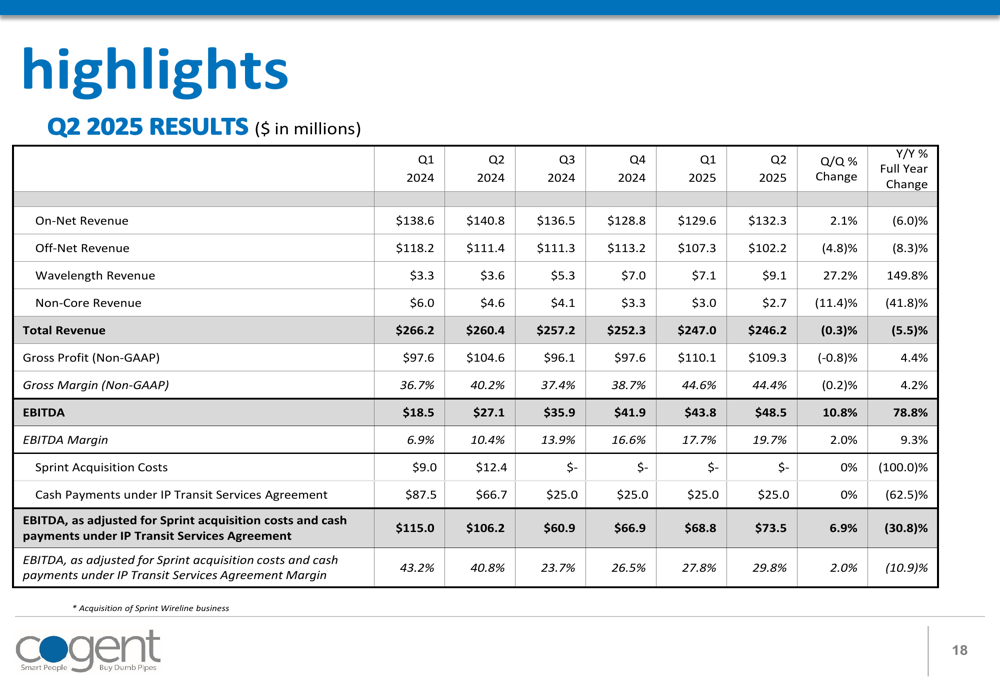
The bright spot in Cogent’s performance was its wavelength services, which grew 27.2% sequentially and 149.8% year-over-year to $9.1 million. On-net revenue also showed positive momentum, increasing 2.1% sequentially to $132.3 million, though still down 6.0% compared to the previous year. However, these gains were offset by declines in off-net revenue (down 4.8% sequentially and 8.3% year-over-year) and non-core revenue.
Adjusted EBITDA, which accounts for Sprint acquisition costs and cash payments under the IP Transit Services Agreement, reached $73.5 million with a margin of 29.8%, showing the company’s focus on operational efficiency despite revenue challenges.
Strategic Initiatives
Cogent is strategically positioning itself for future growth through several key initiatives, with a particular emphasis on expanding its wavelength services network. The company has significantly increased its wavelength service locations, with capabilities in 938 locations as of Q2 2025.
The following map illustrates Cogent’s expanding wavelength services network across the United States:
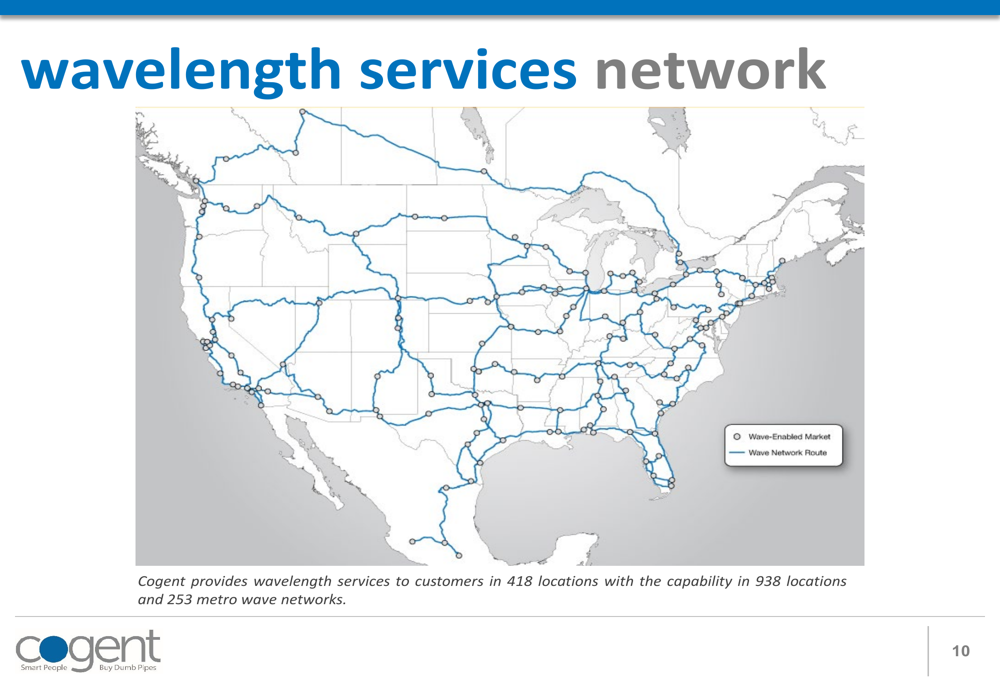
This expansion represents a strategic pivot toward higher-growth segments as the company faces challenges in its traditional business lines. Cogent’s network architecture provides competitive advantages through its use of IRU (Indefeasible Right of Use) and owned fiber, allowing for reduced capital intensity and operating costs.
The company’s growth strategy also leverages its extensive global IP network, which includes 3,529 on-net buildings and interconnections with 8,085 access networks:
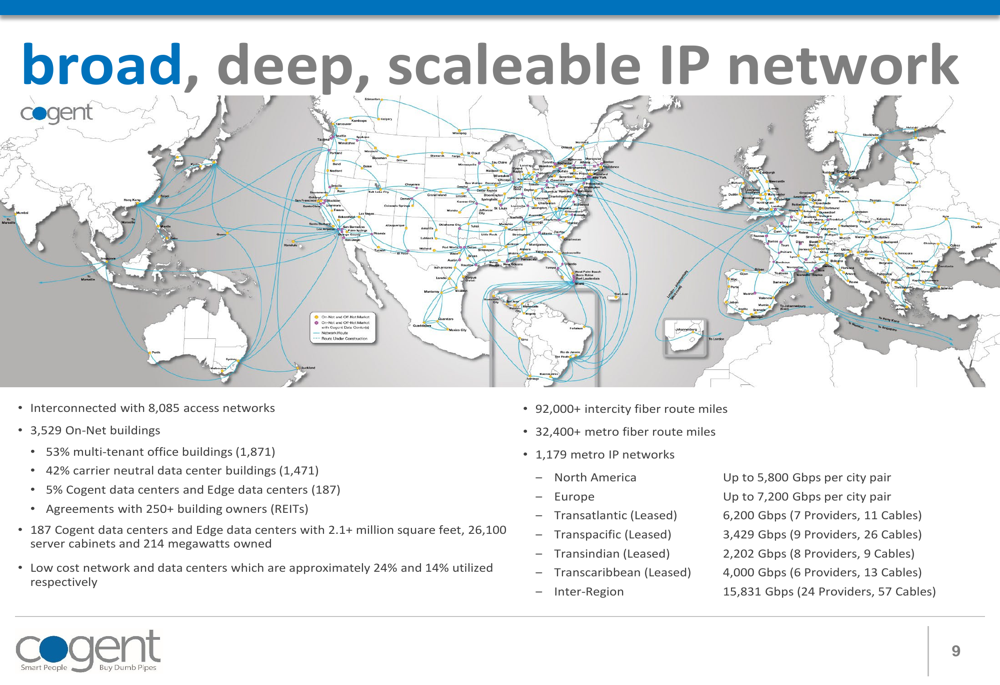
Competitive Industry Position
Cogent positions itself as a low-cost provider with a focus on price and value across its various market segments. The company’s competitive advantages stem from its network architecture, global reach, and operational efficiency.
As illustrated in the following competitive advantage breakdown:
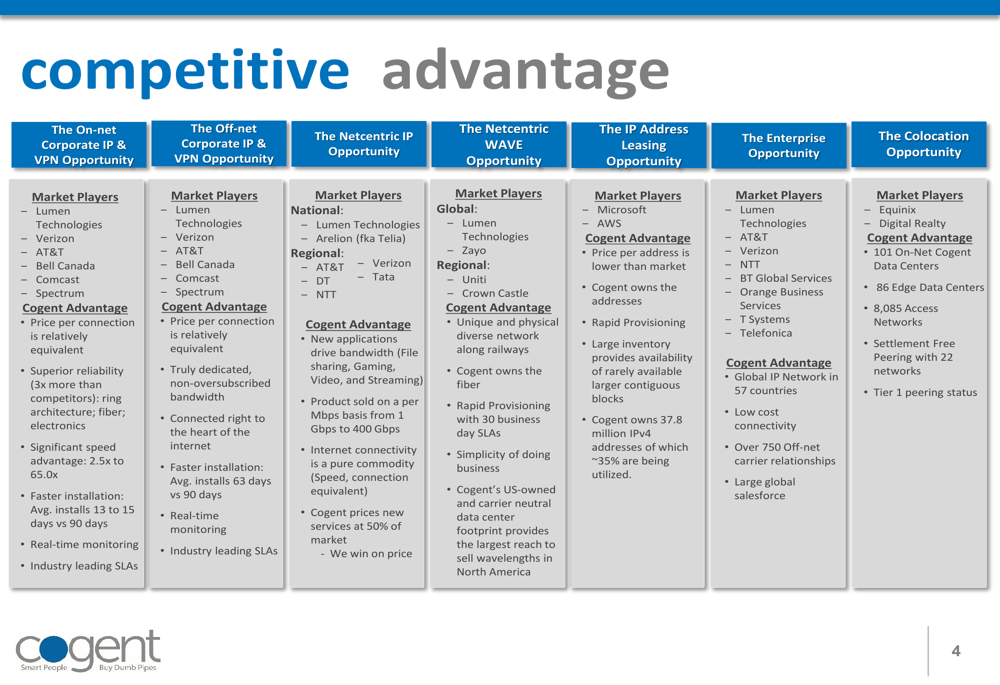
For on-net corporate services, Cogent emphasizes superior reliability, significant speed, and faster installation times (13-15 days versus industry standard of 90 days). In the netcentric space, the company leverages its pricing advantage and connectivity to the internet’s core. The enterprise segment benefits from Cogent’s global IP network and large salesforce.
The company’s growth opportunities span multiple segments, with particular emphasis on the expanding wavelength services market:
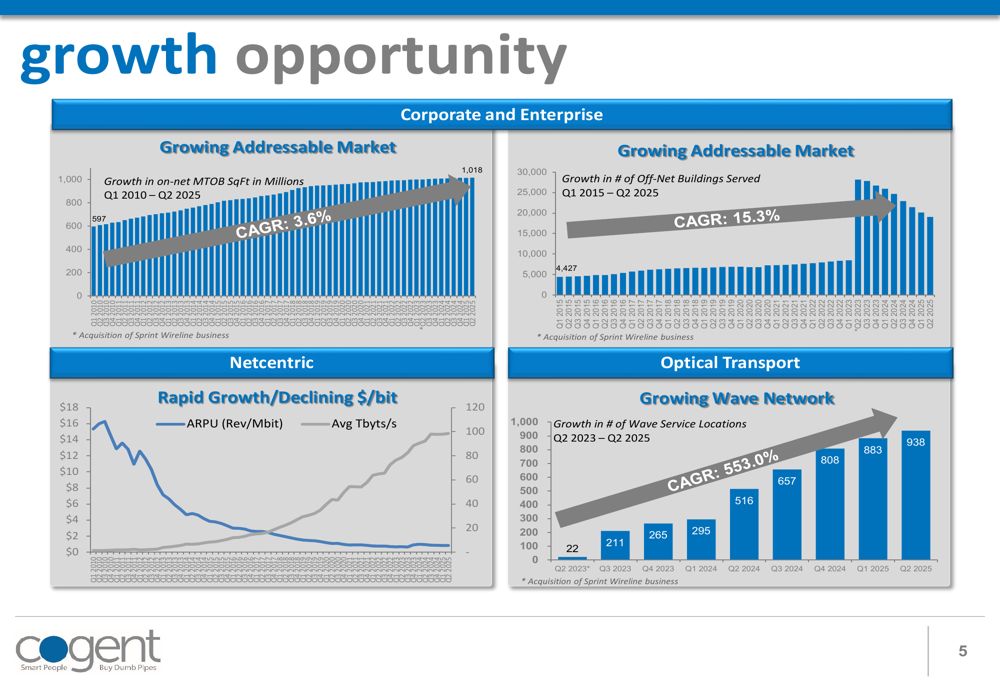
Capital Allocation Strategy
Despite current performance challenges, Cogent maintains a disciplined approach to capital allocation, balancing investments in growth with shareholder returns. The company has returned approximately $1.6 billion to shareholders since its 2005 public offering through dividends and share repurchases.
The following chart illustrates Cogent’s consistent return of capital to shareholders:

In Q2 2025, Cogent continued its share repurchase program, buying back 230,000 shares at an average price of $50.18 per share. The company has also maintained its record of increasing dividends for 52 consecutive quarters, demonstrating its commitment to shareholder returns despite current operational challenges.
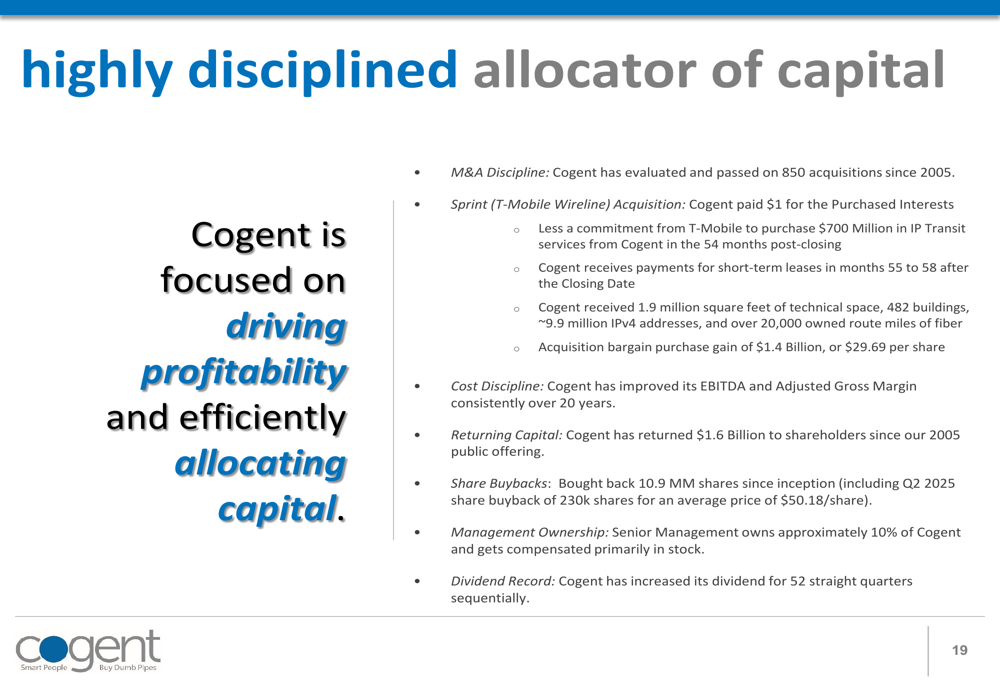
Forward-Looking Statements
Looking ahead, Cogent’s management remains optimistic about future growth prospects despite current headwinds. CEO Dave Schafer expressed confidence during the earnings call, stating, "We expect to return to positive revenue growth each and every quarter sequentially," and highlighted increased confidence in the wavelength business compared to the previous quarter.
The company has set ambitious targets, including:
- Returning to positive sequential revenue growth each quarter in 2025
- Long-term average revenue growth target of 6-8%
- Annual EBITDA margin expansion of 200 basis points
- Targeting $500 million wavelength revenue run rate by mid-2028
These growth opportunities are summarized in the company’s investment highlights:
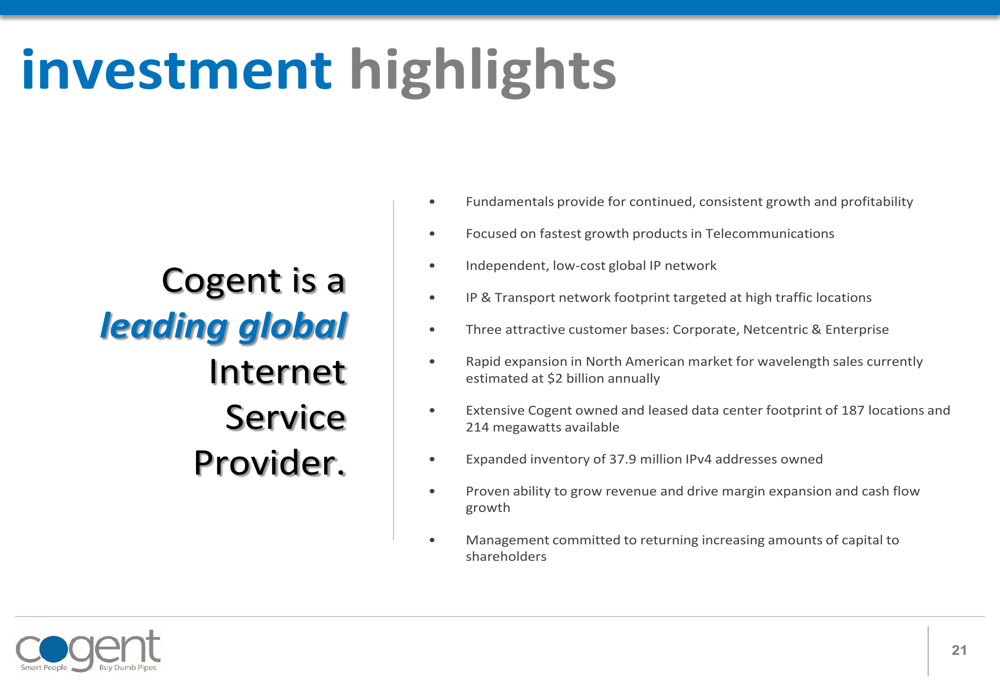
Conclusion
Cogent’s Q2 2025 investor presentation reveals a company in transition, facing revenue challenges in traditional segments while pivoting toward growth opportunities in wavelength services. Despite the optimistic tone of the presentation, the market reaction has been decidedly negative, with the stock dropping significantly following the earnings announcement.
The disconnect between the company’s forward-looking statements and current performance metrics suggests investors remain skeptical about the pace and scale of Cogent’s strategic transformation. While wavelength services show promising growth, they currently represent only a small portion of overall revenue, and the company must execute flawlessly on its strategic initiatives to return to consistent growth.
As Cogent navigates this challenging period, its extensive network assets, disciplined capital allocation, and consistent shareholder returns provide a foundation for potential recovery. However, investors will likely remain cautious until the company demonstrates sustained revenue growth across its business segments.
Full presentation:
This article was generated with the support of AI and reviewed by an editor. For more information see our T&C.
